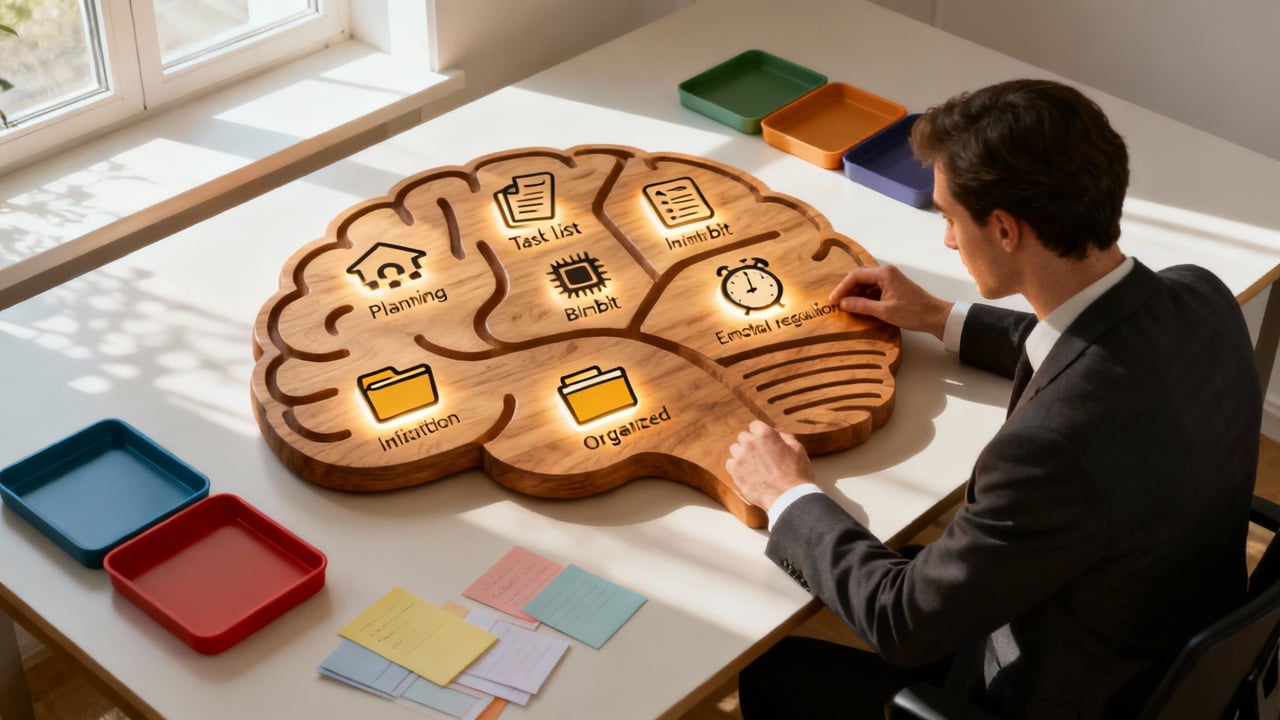Ever find yourself staring at a simple task, knowing exactly what to do, yet feeling completely unable to start? Or maybe you glance at the clock, thinking only a few minutes have passed, only to realize two hours have vanished.
If these moments feel familiar, you’re not alone. They aren’t signs of laziness or a lack of willpower; they are classic executive dysfunction examples.
Executive functions are the high-level mental skills that act as your brain's management team. They coordinate everything from planning and focus to remembering instructions and juggling multiple tasks. For many neurodivergent people, especially those with conditions like ADHD, this internal CEO can feel like it's perpetually on vacation.
To better understand these experiences, it helps to first grasp what executive function is and how it directs our actions. But more importantly, it helps to see these challenges reflected in real life—not as clinical definitions, but as shared human experiences.
This article explores five common ways executive dysfunction shows up. You might recognize yourself in these patterns from work, home, or your relationships. For each one, we’ll explore:
- A real-world scenario to help you feel seen and understood.
- 🔬 A simple scientific explanation of what’s happening in the brain.
- 💡 Actionable, compassionate strategies to help you navigate these challenges.
Our goal is to build a bridge from confusion to clarity. By recognizing these patterns, you can start building a toolkit of effective strategies to support your unique brain.
1. Time Blindness: "I'll just be five more minutes."
Time blindness is a persistent difficulty in perceiving the passage of time, estimating how long tasks will take, and sensing the "future" as a real, tangible thing. This isn't about being careless; it's a genuine neurological difference in how the brain's internal clock works. It's one of the most common and frustrating executive dysfunction examples.
You might recognize this pattern if you feel that time either moves incredibly fast or excruciatingly slow. An hour can feel like ten minutes, or ten minutes can feel like an hour, leading to chronic lateness, missed deadlines, and a constant feeling of being out of sync with everyone else.
🔬 Why It Happens: The Science Behind Time Blindness
Time blindness is linked to the brain's prefrontal cortex and its connection to dopamine, a key neurotransmitter for motivation and time perception. In neurodivergent brains, particularly those with ADHD, dopamine signaling can be inconsistent.
This dysregulation impacts the internal "stopwatch" that helps neurotypical individuals intuitively feel how much time has passed. The brain struggles to sequence events and anticipate future deadlines, making time feel abstract and non-linear.
💡 Actionable Strategies to Manage Time Blindness
Instead of relying on an internal clock that doesn't work consistently, the key is to externalize time. This means using physical and digital tools to make time visible and tangible.
- Make Time Visual: Use a physical timer you can see, like a Time Timer where the red disc shrinks as minutes pass. This provides a constant, low-effort visual cue of time moving forward.
- Embrace Multiple Alarms: Don't just set one alarm for when you need to leave. Set "transition alarms" that warn you ahead of time. For example, set alarms for "15 minutes until I need to leave," "5 minutes until I need to put on shoes," and "Time to walk out the door."
- Schedule Buffer Time: If you think a commute takes 20 minutes, schedule 35 minutes for it. If a meeting ends at 2:00 PM and the next starts at 2:30 PM, treat that buffer as a non-negotiable part of the appointment.
- Time Track to Build Awareness: Use a simple app or a notebook to track how long everyday tasks actually take for one week. You might discover that your "5-minute" shower is really 15 minutes. This data helps you plan more realistically.
Have you noticed this pattern in your own life? The Inflow app is designed to help with these challenges by offering structured routines and reminders that build external scaffolding for your day. Take our quiz to learn how Inflow can support your specific needs.
2. Task Initiation Paralysis: "I know what to do, I just can't start."
Task initiation paralysis is the overwhelming difficulty in starting a task, even when you have the desire, ability, and knowledge to do it. It feels like hitting an invisible wall that separates your intention from your action.
This isn't laziness or procrastination in the typical sense; it's a neurological gridlock. It can happen with tasks ranging from a simple five-minute email to a major project, making it one of the most misunderstood executive dysfunction examples.
People experiencing this often feel stuck, anxious, and frustrated. You might stare at a blank document for an hour, know you need to make a phone call but can't pick up the phone, or see a pile of dishes and feel physically unable to begin, even when the mess causes you distress.

🔬 Why It Happens: The Science Behind Task Initiation Paralysis
Task initiation is managed by the brain's prefrontal cortex, which relies on dopamine to activate and motivate action. For many neurodivergent people, lower or dysregulated dopamine levels can disrupt this "ignition" signal.
The brain struggles to overcome the initial inertia of a task, especially if the task is perceived as boring, overwhelming, or lacking an immediate reward. This creates a disconnect between the part of the brain that knows what to do and the part that gives the "go" command.
💡 Actionable Strategies to Manage Task Initiation Paralysis
The key to overcoming this paralysis is to lower the barrier to entry so much that the "ignition" signal doesn't require as much mental energy. The goal is to trick your brain into starting before it has a chance to resist.
- Use the 2-Minute Rule: Commit to doing the task for just two minutes. Tell yourself, "I only have to load two dishes" or "I only have to write one sentence." Often, the momentum from those two minutes is enough to carry you forward.
- Break Down the "First Step": Instead of "write the report," the first step is "open the document." Then, "write the title." Making the initial action ridiculously small reduces the perceived effort and bypasses the paralysis.
- Try "Body Doubling": Work in the same room (or on a video call) with someone else, even if they're doing a different task. The quiet presence of another person provides external accountability and stimulation that can help your brain get started.
- Change Your Environment: If you always get stuck at your desk, try taking your laptop to a coffee shop or even just a different room. A new setting can break the mental association between that space and the feeling of being stuck.
Learning to finish what you start often begins with finding a way to simply begin. The Inflow app provides structured, step-by-step guidance and accountability tools that can help you break through that initial barrier and build momentum.
3. Working Memory Deficits: "Wait, what was I just saying?"
Working memory is your brain's "mental sticky note"—a temporary space where you hold and manipulate information to complete a task. A deficit in this area means the sticky note has limited space and things fall off easily.
This isn't about long-term memory or intelligence. It’s the struggle to hold onto information in the moment, like following multi-step directions or remembering what you were saying mid-sentence.
People with working memory deficits often lose their train of thought, forget why they entered a room, or struggle to recall the beginning of a question by the time it ends. This can be incredibly frustrating and is one of the most impactful executive dysfunction examples in daily life.
🔬 Why It Happens: The Science Behind Working Memory Deficits
Working memory is heavily managed by the prefrontal cortex. This function relies on a steady, consistent flow of neurotransmitters like dopamine and norepinephrine to keep information "online" and accessible.
In neurodivergent brains, particularly with ADHD, the regulation of these chemicals can be inconsistent. This causes the mental "workspace" to be unreliable, making it difficult to hold onto new information, especially when there are distractions or multiple steps involved.
💡 Actionable Strategies to Manage Working Memory Deficits
The key to managing a weak working memory is to stop relying on it. Instead, you create an external "brain" using tools and systems to hold information for you.
- Write It Down, Instantly: Don't tell yourself you'll remember it later. Capture thoughts, instructions, and to-dos the moment they appear using a pocket notebook, a phone app, or a voice memo.
- Repeat It Back: When given verbal instructions, repeat them back to the person. This act of verbalizing helps encode the information more firmly and also confirms you heard it correctly.
- Use Checklists for Everything: Create step-by-step checklists for routine tasks like your morning routine, weekly grocery shopping, or the process for completing a work report. This offloads the mental effort of remembering each step.
- Chunk and Conquer: Break down complex information into smaller, more digestible pieces. Instead of trying to remember a 10-digit phone number, memorize it in three smaller chunks (e.g., 555 - 867 - 5309). This same principle applies to projects and multi-step instructions.
If you find yourself constantly battling to keep information in your head, Inflow offers tools to help you build these external systems. Learn more about effective ADHD strategies to improve working memory and see how structured support can make a difference.
4. Emotional Dysregulation: "Why do I feel things so intensely?"
Emotional dysregulation is the difficulty managing the intensity and duration of emotional responses. For individuals with executive dysfunction, emotions can feel like a tidal wave—arriving with immense force and receding just as quickly, or lingering long after a situation has passed.
This isn't a choice or a personality flaw; it's a neurological challenge in modulating feelings. It's also one of the most impactful executive dysfunction examples.
Someone with emotional dysregulation might experience a small setback, like a canceled plan, with the same emotional intensity as a major crisis. Reactions can seem disproportionate to the trigger, leading to anxiety spirals over minor mistakes or feeling completely shut down by constructive criticism.
🔬 Why It Happens: The Science Behind Emotional Dysregulation
Emotional regulation is managed by a network between the prefrontal cortex (the "thinking brain") and the limbic system (the "emotional brain"). In neurodivergent brains, the communication pathway between these areas can be weaker.
The prefrontal cortex struggles to apply logic and inhibition to the limbic system's strong emotional signals. This results in an unfiltered, high-volume emotional experience that is difficult to "turn down" or reason with.
💡 Actionable Strategies to Manage Emotional Dysregulation
The goal is not to suppress emotions but to create space between a feeling and a reaction. This involves building awareness and having a toolkit ready before emotional intensity peaks.
- Name It to Tame It: Use an emotion wheel to identify the specific feeling you're experiencing. Simply labeling an emotion as "disappointment" instead of just "bad" can reduce its power.
- Develop a Grounding Toolkit: When you feel overwhelmed, engage your senses to pull your focus back to the present. Try the 5-4-3-2-1 method: name 5 things you can see, 4 you can feel, 3 you can hear, 2 you can smell, and 1 you can taste.
- Practice the Pause: Instead of reacting immediately, commit to a 10-minute delay before responding to a frustrating email or text. This creates a crucial buffer for your thinking brain to catch up.
- Communicate When Calm: Talk to loved ones about your emotional triggers. For example: "When I get really frustrated, it helps me to have 15 minutes of quiet time alone." For more ways to manage intense feelings, you can learn about the RAIN method for ADHD emotions on getinflow.io.
5. Hyperfocus: "I was so in the zone, I forgot to eat."
Hyperfocus is often mistaken for a superpower, but it's a classic example of executive dysfunction related to attention regulation. It’s an intense, single-minded concentration on a task of high interest, to the point where the rest of the world fades away.
This isn't just "getting in the zone"; it's an inability to flexibly shift attention. It can cause you to neglect basic needs like eating or sleeping, or even to not notice when a loved one is speaking to you.
While it can lead to incredible productivity on a passion project, it can also cause you to miss appointments, forget to pick up your kids, or work on a low-priority task for eight hours straight while urgent deadlines pass. This loss of control over your attentional spotlight is one of the most paradoxical executive dysfunction examples.

🔬 Why It Happens: The Science Behind Hyperfocus
Hyperfocus stems from the same dopamine-seeking mechanism that causes distractibility in ADHD. The brain's prefrontal cortex, which regulates attention, struggles to disengage from a highly rewarding, dopamine-releasing activity.
Essentially, the "off-switch" for your attention is impaired. The brain gets locked into a high-stimulation loop, making it neurologically difficult to pull away and re-engage with less stimulating, but more important, tasks.
💡 Actionable Strategies to Manage Hyperfocus
The goal isn't to eliminate hyperfocus but to manage and direct it. You must build an external system of interruptions to do what your brain’s internal system cannot: flexibly shift focus.
- Set Interruption Alarms: Before starting a task you know might trigger hyperfocus, set alarms on your phone for every 45-60 minutes. Label them with specific actions like "Stand up & drink water" or "Check your messages" to force a break.
- Establish Clear End Points: Don't just "work on the project." Define a specific, small goal for your session, such as "I will write the first three paragraphs." When you hit that goal, you have a natural stopping point.
- Create Transition Rituals: Build a habit that signals the end of a hyperfocus session. This could be as simple as closing your laptop, putting away your tools, and walking around the room for two minutes. This ritual helps your brain practice the skill of disengaging.
- Use an Accountability Partner: Ask a friend or partner to check in with you at a specific time. A simple text like, "Hey, just checking if you remembered to eat lunch?" can be the external jolt needed to break the hyperfocus spell.
Inflow helps you harness your focus by creating structured routines and reminders that act as an external attention manager. Take our quiz to see how you can learn to work with your hyperfocus, not against it.
From Understanding to Action: Your Path Forward
Seeing yourself reflected in these executive dysfunction examples can be a profound and validating experience. If you found yourself nodding along or feeling a sense of recognition, you are not alone. This moment of clarity is the most crucial first step. It shifts the narrative from "What's wrong with me?" to "How does my brain work?"
This article wasn't just about listing problems; it was about revealing patterns. The real power comes from understanding that these are not isolated moral failings. They are interconnected symptoms of a brain that processes information, motivation, and time differently. The link between misplacing your keys (working memory) and struggling to start a project (task initiation) isn't a coincidence; it's a neurological signature. Recognizing these patterns transforms shame into actionable self-awareness.
Your Most Important Takeaways
Let's distill the core message from these examples. The goal is not to force your brain to be "normal." The goal is to build a life that supports your brain.
- 💡 Externalize Everything: Your brain's internal hard drive (working memory) gets full quickly. Don't rely on it. Use calendars, phone reminders, and sticky notes. These aren't crutches; they are essential tools, like glasses for someone who is nearsighted.
- 🔬 Break It Down Smaller: The barrier to starting a task is often its perceived size. "Clean the kitchen" is a mountain. "Put three dishes in the dishwasher" is a conquerable first step. Micro-strategies are your most powerful weapon against paralysis.
- ✅ Work With Your Brain, Not Against It: Instead of fighting your tendency to hyperfocus, schedule it. Instead of battling emotional dysregulation with pure willpower, learn to identify your triggers and create a "pause plan." This is about skillful collaboration with yourself.
Actionable Next Steps: Building Your Toolkit
Understanding is passive; action is empowering. The gap between knowing what to do and actually doing it is where many of us get stuck. Here is how to start bridging that gap today.
First, choose just one area of executive dysfunction that causes the most friction in your daily life. Is it planning your workday? Managing frustration? Remembering appointments? Don't try to fix everything at once. Focus on a single pain point.
Next, select one micro-strategy from this article that addresses it. For example, if task initiation is your biggest hurdle, commit to using the "Two-Minute Rule" for one small task today. Just one. The goal is to build a tiny, repeatable win to create momentum.
Finally, remember that managing executive dysfunction is an ongoing practice, not a one-time fix. There will be good days and difficult days. This is where consistent support becomes invaluable. For those facing significant challenges, delving into resources like practical, proven strategies to focus with ADHD can provide targeted guidance to build a more robust toolkit.
Your Journey of Self-Discovery is Just Beginning
Recognizing these executive dysfunction examples in your life is a form of self-compassion. It validates your struggles and provides a framework for moving forward with less guilt and more strategy. You have spent enough time trying to "just try harder." Now is the time to try differently.
If you are ready to turn these insights into a structured, supportive daily practice, consider exploring how Inflow can help. Our app is built on Cognitive Behavioral Therapy (CBT) principles, offering bite-sized, science-backed programs to help you build skills in time management, organization, and emotional regulation. It’s designed for your brain.
Take our ADHD quiz today to see if Inflow is the right next step for you. Your journey of self-discovery and empowerment is just beginning.






.jpg)


